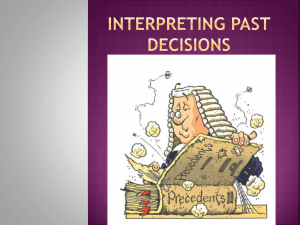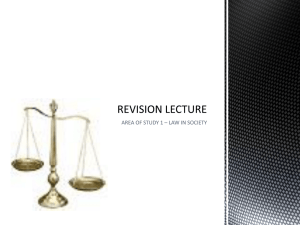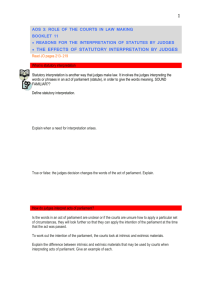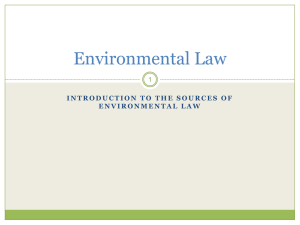Teacher notes Unit 3 Area of Study 3
advertisement
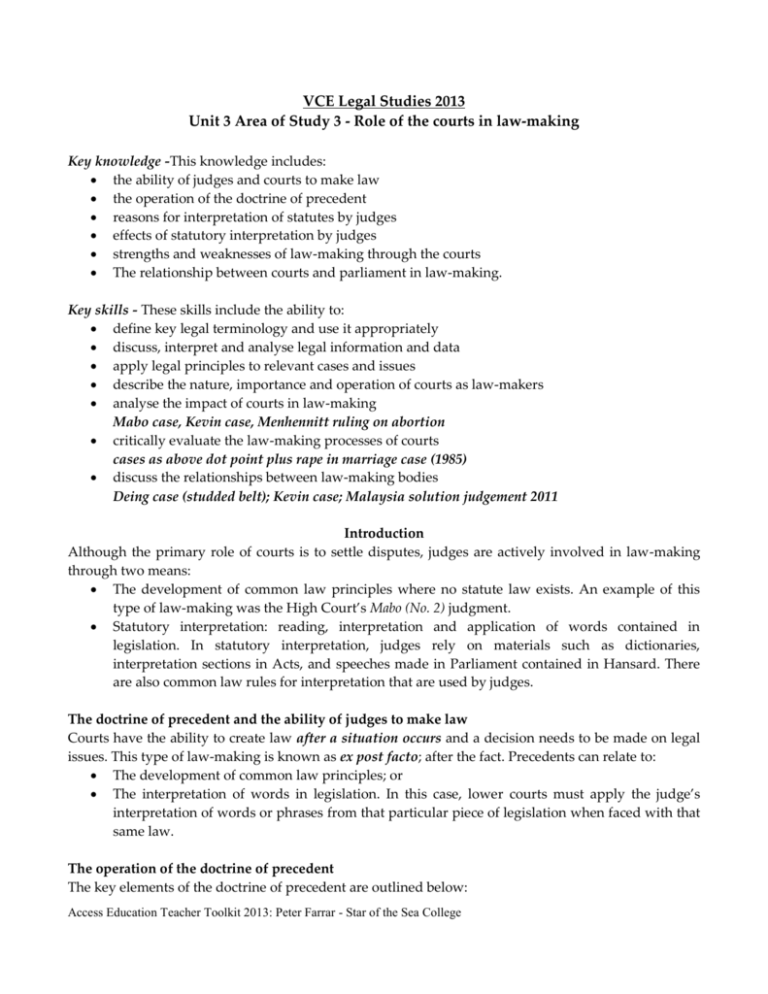
VCE Legal Studies 2013 Unit 3 Area of Study 3 - Role of the courts in law-making Key knowledge -This knowledge includes: the ability of judges and courts to make law the operation of the doctrine of precedent reasons for interpretation of statutes by judges effects of statutory interpretation by judges strengths and weaknesses of law-making through the courts The relationship between courts and parliament in law-making. Key skills - These skills include the ability to: define key legal terminology and use it appropriately discuss, interpret and analyse legal information and data apply legal principles to relevant cases and issues describe the nature, importance and operation of courts as law-makers analyse the impact of courts in law-making Mabo case, Kevin case, Menhennitt ruling on abortion critically evaluate the law-making processes of courts cases as above dot point plus rape in marriage case (1985) discuss the relationships between law-making bodies Deing case (studded belt); Kevin case; Malaysia solution judgement 2011 Introduction Although the primary role of courts is to settle disputes, judges are actively involved in law-making through two means: The development of common law principles where no statute law exists. An example of this type of law-making was the High Court’s Mabo (No. 2) judgment. Statutory interpretation: reading, interpretation and application of words contained in legislation. In statutory interpretation, judges rely on materials such as dictionaries, interpretation sections in Acts, and speeches made in Parliament contained in Hansard. There are also common law rules for interpretation that are used by judges. The doctrine of precedent and the ability of judges to make law Courts have the ability to create law after a situation occurs and a decision needs to be made on legal issues. This type of law-making is known as ex post facto; after the fact. Precedents can relate to: The development of common law principles; or The interpretation of words in legislation. In this case, lower courts must apply the judge’s interpretation of words or phrases from that particular piece of legislation when faced with that same law. The operation of the doctrine of precedent The key elements of the doctrine of precedent are outlined below: Access Education Teacher Toolkit 2013: Peter Farrar - Star of the Sea College Legal principles handed down by courts are interpreted and applied in future cases according to the doctrine of precedent. This involves decisions of higher courts being binding on lower courts in the same hierarchy in similar cases. This is binding precedent. The doctrine of precedent is based on the principle of stare decisis; to stand by things that have been decided. The component of a judge’s ruling that is binding is the ratio decidendi; legal principles that arise from the facts of that case. The part of the judgment that is binding is the legal principles, not the actual verdict or outcome. This is a common error made by students. The obiter dictum is comments made ‘by the way’ in the course of a judgment, which are relevant to the case. The obiter dictum can be used by judges to explain persuasive precedents or indicate to the parliament that reform of the law is necessary. A higher court can overrule or reverse an earlier decision of a lower court in that hierarchy in a similar case. Overruling involves two separate cases, with the first heard earlier in a lower court and the second case being heard in a different matter in a superior court in the same hierarchy. In contrast, reversing only involves only the one case and relates to judgments on appeal to a higher court. Most binding precedents are delivered in the High Court and the Court of Appeal. When studying precedent, it is important to remember that persuasive precedent operates. This occurs where decisions of lower courts and same standing courts in the same hierarchy are persuasive in similar cases. Also, decisions of interstate and overseas courts are persuasive. This is an important element of the courts as a law-maker and is a significant strength of their roles. Judges avoid binding precedent through distinguishing. In such cases, a judge can distinguish an earlier decision if it can be established that the facts of the present case are different to the earlier case to such a degree that the judge in the later case can issue his/her own ruling. A judge may disapprove an earlier persuasive decision by not adopting it. This occurs where courts of same standing in the same hierarchy do not follow their own previous decisions in similar cases. This indicates that a change in law is necessary, because the earlier ruling is no longer appropriate. The difficulty is that in a later case in a lower court, a judge or magistrate may be faced with a range of ratio decidendis on the one issue that have been made by two or more superior judges. The confusion that results from disapproving is overcome by a definitive ratio decidendi from the Court of Appeal or the High Court or by Parliament codifying the law. The effect of interpretation by judges Once judges have read, interpreted and applied words in legislation, that particular interpretation will then become binding on all courts lower in the hierarchy when faced with that particular legislation. For example, if the High Court made a ruling relating to Commonwealth legislation, the particular meaning given by the judges would then be applicable law throughout the nation. Therefore, if people wish to thoroughly investigate the law in a particular area, they would need to read the following: Legislation passed by Parliament Reports of Parliamentary committees, Royal Commissions or the VLRC. The Minister’s Second Reading speech when the original Bill was introduced, found in Hansard. Judicial decisions relating to that legislation. The ratio decidendi of the judgment would give a precise interpretation of the legislation. Any obiter dictum comments by judges as to the application of the law. Access Education Teacher Toolkit 2013: Peter Farrar - Star of the Sea College Once a court has interpreted and applied legislation, Parlt may act to codify or consolidate the law. This means that the legal principles created by the judge may be written into a statute and changed according to the wishes of the Parlt. It is important to remember that Parliament is sovereign. It is the supreme law-maker and any case law delivered by a judge might be codified by Parliament. Significant cases Statutory interpretation Transsexuals Re Kevin and the Validity of Marriage of a Transsexual It is a requirement of a valid ceremony of marriage under the Marriage Act 1961 (Cwlth) that the parties be a male and a female at the date of their marriage. On 12 October 2001 Justice Chisholm of the Family Court of Australia handed down his decision in Re Kevin (validity of marriage of transsexual) [2001] FamCA 1074 which found that a post-operative female to male transsexual had validly married. Facts The husband (Kevin) between October 1995 and September 1998 had undergone sex reassignment surgery. He met his current partner (Jennifer) in 1996. She perceived him as a man and they started living together in February 1997. She was aware of his transsexual situation. In September 1997 the couple applied to an IVF program and Jennifer became pregnant by anonymous sperm donor. In March 1998 Jennifer changed her name to Kevin's. In October 1998 Kevin obtained a new birth certificate on which his sex was shown as male. Kevin was eligible for a passport showing his changed name and stating his sex as male. Kevin had been treated as a man for a variety of legal and social purposes, including by his employer, Medicare, the Tax Office, banks and clubs. Kevin's family, friends and work colleagues accepted him as a man, husband and a father. Psychiatric examination of Kevin revealed no evidence of psychosis or delusional disorder. In mid-1999 Kevin and Jennifer took steps to get married. They gave notice to an authorised marriage celebrant, and made a statutory declaration under the Marriage Act 1961 (Cwlth) stating that they believed that there was no legal impediment to the marriage. On 21 August 1999, the celebrant issued a Certificate of Marriage. Kevin and Jennifer applied for a declaration of validity of marriage and the Commonwealth opposed that application. At issue was the question of whether the husband was a man at the date of the marriage. Decision Key Findings The words 'man' and 'woman' when used in legislation have their ordinary contemporary meaning according to Australian usage and that meaning includes post-operative transsexuals as men or women in accordance with their sexual reassignment. Corbett v. Corbett (otherwise Ashley) [1971] P 83 does not represent Australian law to the extent that there may be circumstances in which a male who at birth had female gonads, chromosomes and genitals may nevertheless be a man at the date of his marriage. Access Education Teacher Toolkit 2013: Peter Farrar - Star of the Sea College On the facts of the case, the husband at birth had female chromosomes, gonads and genitals, but was a man for the purpose of marriage law at the time of marriage having regard to all the circumstances and in particular: he had always perceived himself to be a male; he was perceived by those who knew him to have had male characteristics since he was a young child; at the time of marriage he was perceived as a man, and accepted as a man by family, friends and work colleagues; he was accepted as a man for a variety of social and legal purposes; and his marriage as a man was accepted in full knowledge of his circumstances by family, friends and work colleagues. Corbett (Persuasive precedent) The leading English case on the question of who is a man and who is a woman for the purpose of the law of marriage first arose in the Corbett v Corbett (otherwise Ashley) [1971]. The judge in that case found that the question of sexual identity for the purposes of the law of marriage should be determined by biological criteria. Thus in that case, the fact that April Ashley had subsequently undergone sexual reassignment surgery was irrelevant. Justice Chisholm in Re Kevin held that Corbett does not represent Australian law. What is a 'man'? The Commonwealth argued in Re Kevin that the meaning of the word 'man' in the Marriage Act 1961 (Cwlth) should be taken to be the meaning that would have been given to the word when the legislation was passed in 1961 and that that was the meaning stated in Corbett. Justice Chisholm was of the opinion that: available legal authorities do not show that there is any general rule of construction that ordinary words should be given the meaning they had at the time the legislation was made; there was no convincing reason to conclude that the legislature in 1961 would have had in mind, or should be deemed to have had in mind, a definition of 'man' that incorporated the Corbett approach; it was extremely unlikely that the legislature in 1961 would have envisaged transsexuals and it would be highly artificial to proceed on the basis that they did think about it and wished to incorporate a specific definition invented ten years after the legislation became law; and there was no suggestion in the legal authorities that the right approach to determining the meaning of 'man' and 'woman' is to ignore medical knowledge and base the decision on what the legislature might have thought the words meant at the time of the relevant legislation. International legal developments Justice Chisholm in Re Kevin reviewed legal developments in other countries regarding the legal recognition of a transsexual's reassignment, including recognition for marriage purposes. Justice Chisholm found that in Europe, while there is no common approach and preconditions vary, there is a growing tendency to recognise a transsexual's acquired gender. Access Education Teacher Toolkit 2013: Peter Farrar - Star of the Sea College Justice Chisholm pointed to the fact that Austria, Denmark, Belgium, Finland, France, Germany, Italy, the Netherlands, Portugal and Sweden allow a transsexual to marry in the reassigned sex. In contrast England, South Africa and Canada continue to follow Corbett. In New Zealand it has been held that Corbett does not represent the law and a transsexual's change of sex is recognised for the purpose of the validity of a marriage. Focus questions 1. Outline the key facts of the Kevin case. 2. In your own words, explain the requirements for a valid marriage under the Marriage Act 1961 (Cwlth). 3. Explain the persuasive precedent that existed for the Family Court in this case. Was this precedent adopted by the Family Court of Australia? Give reasons for this decision. 4. Outline the relationship between the parliament and the courts that is highlighted in this case. 5. To what extent does the Kevin case demonstrate the strengths and weaknesses of the parliament AND the courts as law-makers? Plain packaging of cigarettes From Big tobacco loses High Court battle over plain packaging The Age 15/08/12 In August 2012, the federal government secured a big win over big tobacco with the High Court ruling Labor's plain packaging laws are constitutionally valid. The decision is expected to have significant influence globally with both the United Kingdom and New Zealand considering plain packaging. It clears the way for the government to impose a ban on all brand marks and logos on cigarettes, to take effect from December 2012. Large graphic health warnings will dominate packs and the manufacturers' brand names will be written in small generic font. The govt said plain packaging was a measure "which removes the last way for big tobacco to promote its deadly products. Over the past two decades, more than 24 different studies have backed plain packaging, and now it will finally become a reality." The High Court ruled that the plain pack legislation is not contrary to Section 51(xxxi) of the Australian Constitution. Tobacco companies argued before the High Crt that the govt was depriving them of copyright. During the hearings in April the companies, including British American Tobacco, argued that the Commonwealth law breached the constitutional requirement that the acquisition of property by the government be on just terms. But to make that case, the companies had to show that the government gained a measurable benefit as a consequence, which is apart from the benefits to the health of the population. The Commonwealth responded that the companies' case could not succeed Access Education Teacher Toolkit 2013: Peter Farrar - Star of the Sea College unless it could be shown that the government had taken property from them. The High Court agreed with the Commonwealth that the plain packaging legislation was constitutional. Following the High Court ruling, other countries indicated that they might adopt the Australian law. In this case, it was important that cigarette companies could ask judges to consider the validity of such a law and the decision is regarded as important on a global level. The High Court and the Malaysia solution Plaintiff M70/2011 v Minister for Immigration and Citizenship [2011] HCA 32 High Court ruling In August 2011, the High Court ruled invalid the Minister for Immigration and Citizenship's declaration of Malaysia as a country to which asylum seekers who entered Australia at Christmas Island could be taken for processing of asylum claims. In a majority (6-1) ruling, the High Court issued prevented the Minister from taking to Malaysia two asylum seekers who arrived at Christmas Island. The Court also decided that an unaccompanied asylum seeker who is under 18 years of age may not lawfully be taken from Australia without the Minister's written consent under the Immigration (Guardianship of Children) Act 1946 (Cth). The Court granted an injunction restraining the Minister from removing the second plaintiff, an Afghan citizen aged 16, from Australia. The Court ruled that under the Migration Act 1958 (Cth), the Minister cannot nominate a country to which asylum seekers can be taken for processing unless that country is legally bound to meet three criteria. The country must be bound by international law or domestic law to provide: access for asylum seekers to effective procedures for assessing their need for protection; protection for asylum seekers pending determination of their refugee status; and Protection for persons given refugee status pending their voluntary return to their country of origin or their resettlement in another country. The High Court held that Malaysia is not legally bound to provide the protection that the Migration Act requires and Malaysia is not a party to the Refugees Convention or its Protocol. The parties agreed that Malaysia is not legally bound to, and does not, recognise the status of refugees in its domestic law. Political fallout In September 2011, the Gillard Cabinet discussed the asylum-seeker dilemma. The Greens vowed to oppose any changes to the Migration Act that were aimed at overcoming the High Court's ruling against the Malaysia deal, leaving Gillard entirely dependent on Coalition support to get new laws through the hung parliament. The Malaysia deal, which Gillard was trying to resuscitate by amending the Migration Act in line with the High Court ruling, would have seen 800 asylum-seekers sent to Malaysia in return for Australia taking 4000 declared refugees. Australian National University law professor Don Rothwell said it should be possible to amend the migration laws in a way that allowed asylum-seekers to be sent to some countries, but not others. Links to Unit 3 VCE Legal Studies course This is an example of the original jurisdiction of the High Court to hear cases involving laws made by the Cwlth. It is important to note that this case does not involve constitutional power but whether ‘the Malaysia solution’ was in conflict with the Migration Act1958 (Cwlth). Access Education Teacher Toolkit 2013: Peter Farrar - Star of the Sea College The role of the courts in settling disputes and, through statutory interpretation, clarifying the law and addressing ambiguities in legislation. This is an example of the relationship between parlt and the courts in the law-making process. This highlights problems faced by a minority government, which needs to deal with the opposition parties in an effort to revive its policy on off-shore processing of asylum seekers. Focus questions 1. Explain the legal rule that was made by the Minister in this case. 2. What safeguards are provided for asylum seekers in the Migration Act? 3. Why did the High Court hear and determine this dispute? 4. What was the outcome of the case? 5. To what extent does this case illustrate the weaknesses of the parliament as a law-maker? 6. Explain the principle of the separation of powers. How is his principles reflected in the Malaysia Solution case? Significant cases: Development of common law principles Developments in Native Title law in Australia When the British flag was unfurled in Australia on 7 February 1788, Governor Phillip claimed the continent under international law for King George III of Britain. Under these international laws, there were three ways of acquiring sovereignty over land1. By military conquest, where one country defeated another at war. 2. By cession, which involved a country (either voluntarily or under duress) giving over land to another country. In some instances, two or more countries entered into a treaty in order to establish new geographical boundaries, and create new laws. 3. Through occupying land considered ‘terra nullius’ (‘land belonging to nobody’). It was this means of acquiring sovereignty that was used by the British in 1788. What is terra nullius, and how did it apply to Australia? Although the British knew of indigenous people in Australia before 1788, ‘terra nullius’ was still thought to apply. This is because international law stated that land occupied by ‘backward peoples’ was considered vacant. (If people could not defend themselves against invaders, then they must be primitive, not deserving the right to land.) Under common law, land was acquired by ‘settlement’. Land and Sea Ownership in Australia 1788 to 1992 When the British claimed Australia, over one million indigenous people were instantly standing on soil or fishing in seas that were owned and controlled by King George III. It took 204 years for the law to recognise this prior occupation of the continent. What relationship do indigenous people have with the land? The British brought with them expectations of Australia that were soon overturned. Three key expectations of the British were as follows (expressed as a role-play) Andrea: Jess, is it true that the Aboriginal population is small in number? Jess: Great question, Andrea! When the British arrived, it was clear that there were thousands of Aborigines living at Sydney Cove. There were more indigenous people in a 10-kilometre radius of Sydney Harbour than there were passengers and crew on the First Fleet! Access Education Teacher Toolkit 2013: Peter Farrar - Star of the Sea College Andrea: Are the inland areas uninhabited? Can people survive there? Jess: Actually, Andrea, in May 1788, Governor Phillip led an inland expedition, and he found temporary huts that had been built by Aborigines. He also saw smoke coming from high in the Blue Mountains. He concluded that indigenous people live at least 50 kilometres inland. In the 1840s, the famous explorer Edward Eyre was surprised to find indigenous people living in the most harsh and barren landscape imaginable. Andrea: The things you learn when you’re not on Facebook chat! We originally thought that the Aborigines were nomadic hunters, not attached to any particular area of land and sea. Is this true? Jess: It gets better!! Journal entries from members of the First Fleet comment on the Aborigines’ extensive knowledge of plant and animal life. The British expected that indigenous people survive only on their capacity to hunt game and catch fish. They found that the people on the East Coast of Australia had such a keen understanding of their local area that they did not have to venture far from base to discover food or water. Andrea: Now, that IS amazing! The Mabo Revolution and Beyond Until the Mabo judgment of 1992, native title was not recognised in Australia. Despite calls for change, Parliament had not overturned terra nullius, which dated from the 17th Century. What was the basis of the claim in the Mabo case? This case involved a land claim by the Meriam People of Queensland. Led by Mr Eddie Mabo, the group took its case to the High Court, where they claimed that they held native title rights over the Murray Islands that pre-dated the First Fleet. What did the High Court decide? The High Court was asked to consider whether the Meriam People had a system of laws on issues such as land ownership. In a majority ruling, the judges decided that these people have a rich and vibrant culture that operated when Governor Phillip claimed ‘radical title’ over Australia in 1788. The judges found that this ‘radical title’ gave the sovereign the right only to distribute land, and the prior and continuing occupation of Australia’s Aboriginal and Torres Strait Islanders must be recognised under common law. The concept of ‘backwards people’ was dismissed. The Mabo ruling said that land could be subject to a native title claim if it had not been sold or leased for private use. Indigenous people could seek native title rights if they could establish a continuing physical or spiritual connection to the land that pre-dates 1788. Justice Brennan clearly explained the application of this new form of title. ‘Where a clan or group has continued to acknowledge the laws and (so far as practicable) to observe the customs based on the traditions of that clan or group, whereby their traditional connection with the land has been substantially maintained, the traditional community title of that clan or group can be said to remain in existence.” Therefore, in order to obtain recognition of native title, the following must be proven The existence of a clearly identifiable indigenous group On the basis of laws and customs belonging to that group, a traditional connection to land or sea. This may involve evidence of burial sites and indigenous art works This connection must have remained to a substantial degree over a period of time Access Education Teacher Toolkit 2013: Peter Farrar - Star of the Sea College What is the effect of the Racial Discrimination Act 1975 on native title cases? In 1975, the Commonwealth passed an Act to make it unlawful to discriminate against a person on the basis of individual characteristics, including race. The law is binding on all people in Australia, including governments of the states and territories. The Racial Discrimination Act had a significant effect on the common law principles laid down in the Mabo case. No government in Australia could extinguish native title without negotiation with holders of the title. If they did extinguish these rights, issues of compensation arose. In the Mabo ruling, Justice Brennan stated that governments should uphold Section 10 of the Racial Discrimination Act, which states that the rights of native title holders to own and inherit property must be preserved. Governments cannot interfere with this basic human right that is available to all Australians. How did the Commonwealth Parliament respond to the Mabo judgment of 1992? When the judgment was made, there were calls for a response from the Cwlth to make clear the rights and responsibilities of all parties in native title claims. The Cwlth began drafting a Bill that would establish the legal framework to support principles set down by the High Court. After 11 months of debate the Bill passed the Senate to become the Native Title Act. While Parliament made it clear that vacant Crown land could be subject to native title claims, the position regarding pastoral leases was unclear. Parliament had written in the preamble to the Act that pastoral leases were to be ‘safe’ from claims, although no mention of this was made in the actual law. This led to the Wik case. What were the key facts in the Wik case? In 1996, the Wik Peoples made a native title claim for land on which two pastoral leases in Northern Queensland had been granted; a total of 3,765 square kilometres. These leases were granted in the early 20th Century, but the land had not been used extensively. What did the High Court decide? The judges examined the Native Title Act and the debates in Parlt at that time. The Court ruled that native title could be claimed on pastoral leases if the activities of the people making the claim would not ‘inconvenience’ the leaseholder. In the Wik case, the land involved had been vacant for decades; the judges said that native title holders should enjoy access to land without inconveniencing others. Leases could now be shared with native title holders if indigenous people accessing land did not remove fences or machinery, or interfere with livestock. This is known as the principle of coexistence. The decision upheld the intention of pastoral leases, which involves use of land for a specific purpose such as grazing; it is not like freehold title. Indigenous people could now access their sacred sites. The Native Title (Amendment) Act 1998 (Cwlth) Some pastoralists said that they had spent much money developing leases and they did not want to share land. In response, Parliament changed the Native Title Act as follows Once a pastoral lease had been granted, native title claims could not be made over the land covering the lease. Coexistence was therefore removed from the law. The registration test by which indigenous people prove links to land be tightened. Under the 1993 Act, a physical or spiritual link was needed. A spiritual link could be proven by reference to land as being a part of the cultural heritage of that group. The 1998 amendments replaced the spiritual test Access Education Teacher Toolkit 2013: Peter Farrar - Star of the Sea College with the requirement of a physical link. This involves proof that burial sites or artworks from that particular group can be found on the land. In the case of people forcibly removed from land by governments, they only had to prove that they occupied that land before being removed from it. Mini test: Native Title 1. Define the following terms: a) stare decisis b) ratio decidendi c) obiter dicta (3 x 2 marks) 2. Outline the two means by which courts may amend the existing common law. (4 marks) 3. Explain the basis of the High Court decision in Mabo and Others v The State of Queensland 1992. In your answer, describe the key legal principles surrounding Native Title. (5 marks) 4. Explain the ways in which the development of legal principles in the area of native title highlights the roles of parliaments and courts as law-makers. In your answer, make reference to the following examples Court judgment in the Wik case, and Parliamentary debates following the Wik judgment and the eventual passage of the Native Title (Amendment) Act (1998) Cwlth. (10 marks) * * * * Suggested solution 1. a) The term stare decisis means to stand by things decided. This is the basis of the Doctrine of Precedent in terms of binding principles. b) The ratio decidendi of a judgment is that part of the judge’s ruling that establishes binding legal principles to be followed in future cases. It is the ‘reason for the decision’. c) The obiter dicta of a judgment is that part of the judgment which contains general references to facts and law, although no legally binding statements. For example, the judge may refer to the need for law reform in a particular area. 2. Students would be expected to explain the procedures of reversing (one case, taken on appeal to a higher court), and overruling (two separate cases). With overruling, the second, later case has been heard in a higher court in the same hierarchy, and it has similar fact situations to the earlier case where the original ratio decidendi was created. Students would need to explain that in both instances, new case (common) law has been created, that will become binding on lower courts in the same hierarchy in similar cases. 3. The essence of Mabo was the removal of the principle of terra nullius from the Australian common law. Both terra nullius and native title would need to be defined and explained. As a result of the Mabo decision, indigenous groups could undertake legal proceedings to claim Native Title rights on Crown land. The Court held that Native Title is only extinguished in situations where land has been purchased or leased for private use. Access Education Teacher Toolkit 2013: Peter Farrar - Star of the Sea College 4. As an explain question, students would be expected to highlight the roles of Parliament and the courts as law-makers. The processes for the creation of law by parlt and courts would need to be explained, together with the relationship between law-making bodies. Some suggested points for answering question 4 are as follows: Courts The Wik ruling shows that courts are able to interpret words contained in legislation (in this case, the Native Title Act of 1993), and make rulings based upon the evidence. This is especially important where the legislation is ‘silent’ on an issue. The issue of Native Title claims on pastoral leases had not been clearly stated in the 1993 Act, so the High Court clarified this issue. In this case, the Court conducted itself in an activist role, setting the agenda for the continuing debate over reconciliation and land rights. The Court’s primary role may be to settle disputes, but its role as a law-maker is evident here. Parliament With the passage of the Native Title (Amendment) Act 1998, the Commonwealth addressed some of the difficulties that had arisen since Wik. The issue of coexistence on pastoral leases was resolved in favour of pastoralists, with the right to negotiate on pastoral leases being effectively eliminated. The Act also tightened the law with regard to the registration (threshold) test which had to be satisfied by indigenous people when making a Native Title claim. This legislation demonstrated the capacity of Parliament to respond to the need to reform law where uncertainty has arisen, and to take account of the wide range of public opinion on such controversial issues during the parliamentary debate and Committee processes. Of course, the outcome of the Ward case may once again shed more light on whether native title rights can in fact be revived at the end of a lease. Focus questions The Parliament of the Commonwealth of Australia THE SENATE Presented and read a first time Native Title Amendment (Reform) Bill (No. 1) 2012 No. , 2012 (Senator Siewert- Australian Greens) A Bill for an Act to amend the Native Title Act 1993 to further the interests of Aboriginal peoples and Torres Strait Islanders, and for related purposes a) Describe the next stage in the passage of this bill through the parliament. b) This bill was read for the first time in the Senate. Outline THREE roles played by the Senate in the Commonwealth Parliament. c) How do we know that this legislation is a private members bill? What difficulties would such legislation have in attempting to receive majority support in both houses of parliament? d) To what extent are private members bills a strength of the parliament as a law-maker? ............................................ Access Education Teacher Toolkit 2013: Peter Farrar - Star of the Sea College

